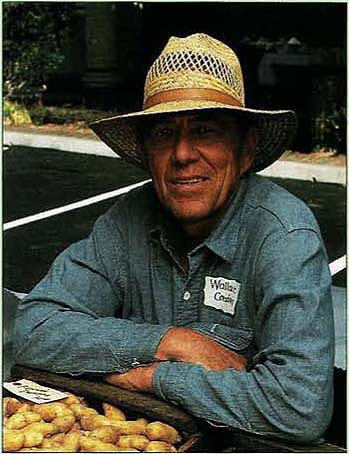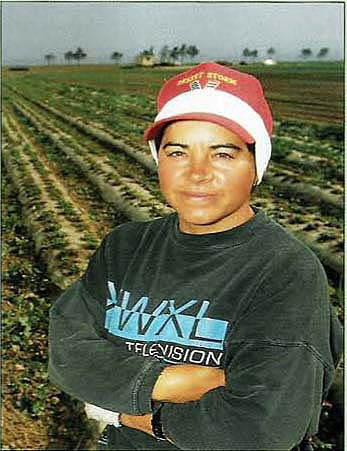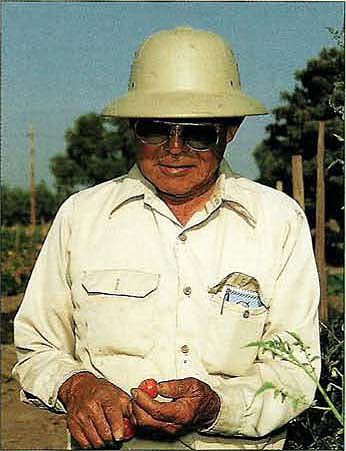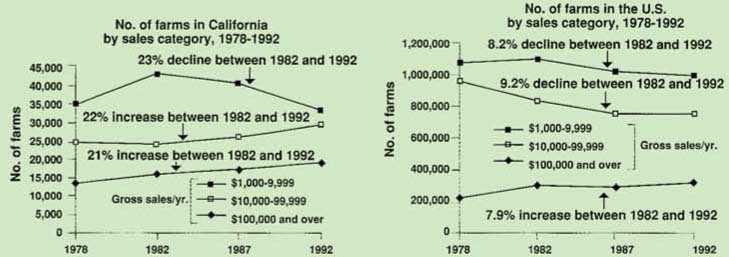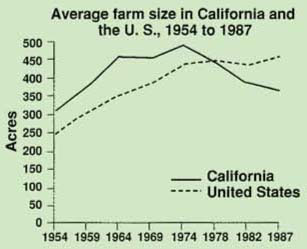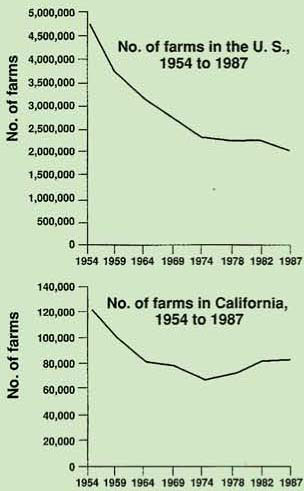All Issues
Small farmers: Who are they and why do they matter?
Publication Information
California Agriculture 47(2):6-7.
Published March 01, 1993
PDF | Citation | Permissions
Full text
Wallace Condon, a retired school teacher, grows Yellow Finn potatoes that “look like bent French fries” but are valued for exceptional flavor.
A Fresno County farmer for 5 decades, Shig Hayashi applies UC-developed “pheromone confusion” to control tomato pinworms and reduce chemical insecticide use.
For many Americans, the small family farm evokes a white clapboard farmhouse, a red barn, a towering grain silo, and chickens scurrying about. This may be an accurate description of a 160-acre section in today's Midwest, but it does not mirror a “typical” California farm. In the nation's highest grossing farm state, agriculture is far more diverse.
While corn, wheat and soybean crops dominate Midwest agriculture, California's cornucopia includes 250 crops and livestock commodities, the “big” ones like cotton, dairy, almonds, rice, and citrus, as well as those grown on a smaller scale - mixed lettuces, goats, mushrooms, elephant garlic and other “specialties.”
More than 90% of California's food and fiber is grown on 19,000 farms grossing more than $100,000 yearly. The rest is grown on 29,000 farms grossing between $10,000 and $100,000, and 33,000 minifarms grossing less than $10,000. Although these smaller farms may be overshadowed by their corporate cousins, their sheer numbers contribute significantly to rural economies. In California:
-
They produce more than $1 billion in annual sales.
-
They pay about 38% of agriculture's property taxes.
-
They own about one-third of the state's farm machinery — more than half of the tractors and pickup trucks.
The demand created by small farms for balers, tractors, spray rigs and harvesting equipment helps keep agricultural costs down. The American Farmland Trust suggests that “what has generally been viewed as the ‘inefficiency’ of small farms - a high ratio of inputs to output - could, in fact, be viewed as a subsidy that tends to reduce the costs of production to the large farmers who grow most of our food.”
Small farmers contribute in other ways. They grow many of California's specialty crops — and often grew them first. Kiwis, virtually unheard of 20 years ago, are now commonplace. Within the last decade small farmers have revitalized California restaurants and kitchens with a flood of specialty fruits and vegetables.
Figs. 1 and 2. In California, small farms with sales of $10,000 to $100,000 have increased 22% in the last decade. In contrast, nationwide, farms with sales of $10,000 to $100,000 have decreased 9% during the same time period.
Fig. 3. In the mid-1970s the state's average farm size began to decline. Simultaneously, farmer's markets burgeoned after a 1977 CDFA ruling allowed sale of produce in nonstandard packs at certified farmers' markets.
Ron Voss, director of UC's Small Farm Program, concludes that small farmers have had a lasting influence on California agriculture, particularly in the organic farming movement, which has brought issues of sustainability, environmental quality and food safety to the attention of the academic community - and of the public. Today's nearly 200 certified farmers' markets are populated mostly by small farmers. Representing diverse cultures, small farmers bring new customs, cuisines and traditions to their communities. Nearly all farms run by women and ethnic minority farmers are small.
“Small farmers,” Voss says, “are helping to educate a population of Californians several generations removed from the farm about the origin and nature of their food. Small farms also are major contributors to the preservation of California's rapidly vanishing open space both near and far from urban centers.”
For many years, U.S. census data have shown farm numbers declining and average farm size increasing. For instance, of the 6 million farms in the United States in 1940, 133,000 were in California. By 1978 the number of farms had dropped to 2.2 million nationally and to 73,000 in California. Average farm size grew to 450 acres statewide and nationally.
Within the last decade, however, the size of the average California farm has dropped to 360 acres, but farm numbers have increased to 81,000. Nationally, farm size has edged up to 467 acres. To a large extent, the trend in California can be explained by the increase in farms in the $10,000-to-$100,000 category (an increase of 22% from 1982 to 1992).
Fig. 4. The total number of farms in the U.S. has been declining since at least 1954. California followed the same trend until 1974, but since then the total number of farms in California has been increasing.
Economic Impact:
- Small farms in California…
-
Have total sales of over $1 billion per year.
-
Own 31% ($1.3 billion worth) of the market value of the machinery and equipment used on farms.
-
Own 57% (90,551) of the trucks and pickups used on farms.
-
Own 53% (80,498) of the wheel tractors used on farms.
-
Pay 38% ($93 million) of the property taxes paid by farms in the state.
-
Receive 15% ($36.7 million) of government payments to farms.
Characteristics:
- Small farms in California…
-
Represent 79% of the farms in the state.
-
Represent 36% of the land in farms.
-
Average 167 acres in size.
-
Are more than twice as likely to be owned by an individual or family than are large farms (84% vs. 40%).
-
Represent 91% of farms operated by women.
-
Represent 83% of farms operated by people of Spanish origin.
-
Represent 73% of farms operated by people of black and other non-white races.
Small farms are those with sales between $1,000 and $99,999. Data based on the 1987 Census of Agriculture for California, table 52.
Income and acreage figures help identify small farmers, but the Small Farm Program asks other questions in developing educational programs: Is a family operating the farm? Is the family gaining its livelihood from farming? What kind of education is needed? What kinds of experience do small farmers offer? What kinds do they lack? What are the cultural and language barriers? Answers to these questions indicate that California's small farmers encompass a broad spectrum of ethnicity, age, employment status, philosophical orientation, production methods, marketing goals, growing conditions, and crop or animal mix.
In the 1970s, the program's primary audience was Hispanic farm workers trying to establish independent farms. Today, the audience includes Southeast Asian refugees, organic farmers, specialty crop and animal growers, farmers' market managers, retirees, part-timers and others. “Their specific needs may vary,” Voss says, “but what they have in common is a need for information that will help them succeed. The Small Farm Program's purpose is to help them toward that end.” — J. Stumbos
Sources: 1978, 1982 and 1987 data from the Census of Agriculture, 1987, U.S. Department of Commerce, Bureau of the Census. 1992 data from Farm Numbers/Land in Farms, USDA National Agricultural Statistics Service.



